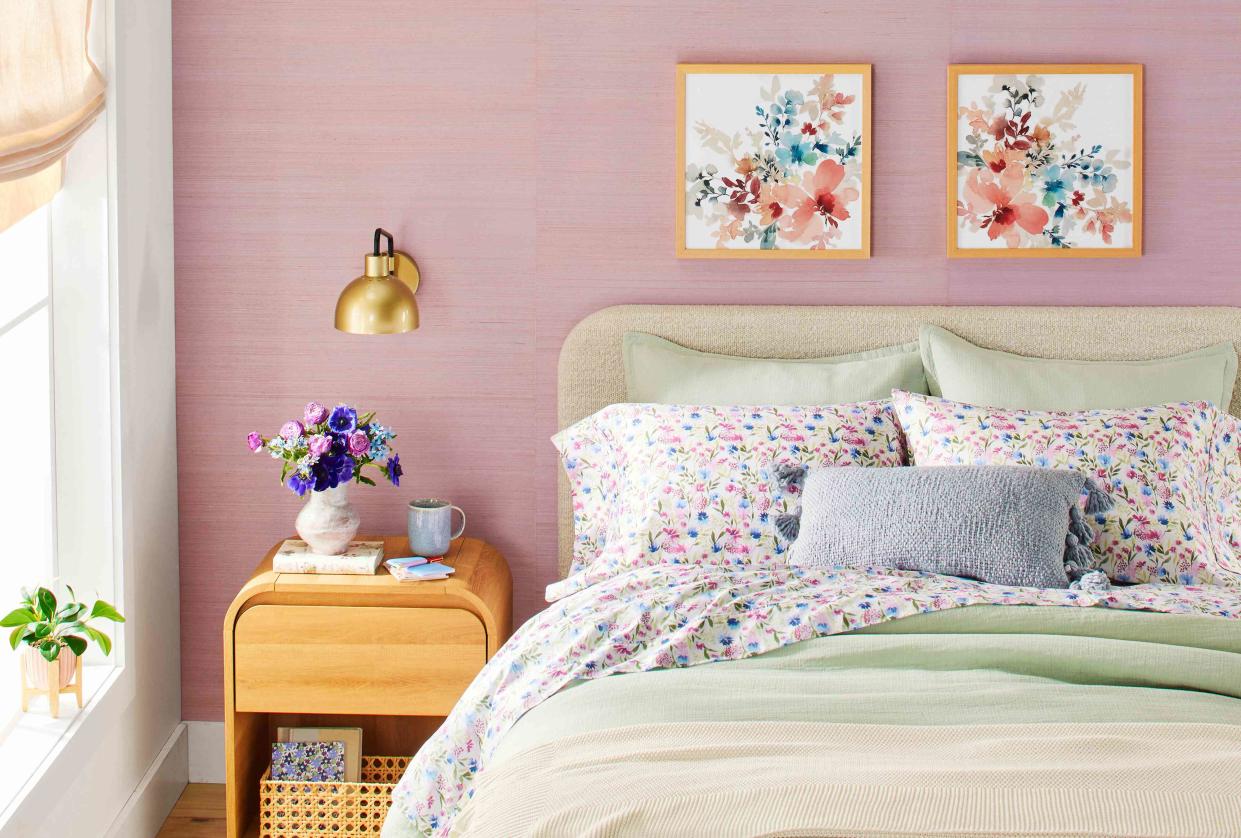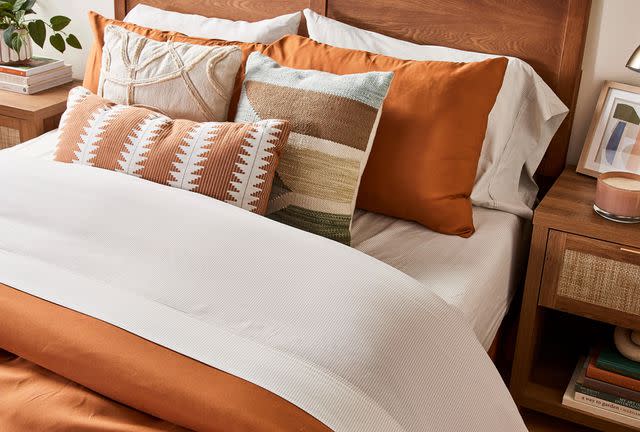Discover the Best Type of Sheets for Your Sleep Preferences
Get to know the various materials, weaves, and thread counts of bed sheets so you can choose the perfect set.

Jacob Fox
With so many different types of sheets to choose from, the possibilities might seem endless. To help you navigate the options, we’re sharing all the details you need to consider before landing on your new favorite bed sheets. From materials to weaves to thread count, here’s your game plan for finding the perfect sheets.
Related: 3 Bedding Trends You Can Try Using Picks from the BHG Line at Walmart
Bed Sheet Materials
The material of your bed sheets can affect not only how much you spend, but also impact durability, sleep temperature, and more. To help you get the best night's sleep, start by determining what sheet material is best suited for your needs.
Bamboo Sheets
Bamboo sheets have several appealing qualities.
For starters, they’re environmentally friendly due to the rapid growth rate of bamboo—a material also used to make other household materials like towels, reusable makeup remover pads, coffee filters, toilet paper, and more.
Bamboo sheets are wrinkle-resistant, hypoallergenic, cool, and highly breathable.
They also have a high durability.
They clock in ahead of both polyester and linen when it comes to softness.
As far as price point, bamboo sheets are often more expensive than most cotton sheets, though you can consider it a more price-conscious alternative to Egyptian cotton.
Related: The 10 Best Bamboo Sheet Sets, According to Lab Testing
Cotton Sheets
Cotton is the most common material for bed sheets, which probably won’t come as a surprise once you realize how many cotton sheet varieties are on the market and how broad the range in price.
A few of the most common types of cotton sheets you’ll encounter include:
Egyptian cotton
Pima
Jersey
Flannel
Egyptian cotton and Pima are both high-quality varieties that utilize superior thread that is both longer and smoother than other cotton varieties. When it comes to softness, Egyptian cotton has the edge, which means you can typically count on Pima for a lower price point.
Broadly speaking, cotton both absorbs moisture and distributes heat well, which makes it a great, breathable choice for those who like to sleep cool. Flannel sheets will be warmer while Egyptian and Pima provide cooling benefits.
Related: The 11 Best Cotton Sheets of 2024, According to Testing
Linen Sheets
Linen sheets bring texture and charm, but they have other benefits, too.
The naturally cooling material is a breeze for regulating your body temperature while you snooze.
Linen sheets are also hypoallergenic, soften over time, and designed to last.
However, linen is unlikely to hit the level of softness you’ll get with cotton. Linen sheets typically have a higher price point than cotton, though high-quality linen can benefit from a longer life that can assuage some of the investment concerns.
Linen sheets should be washed on a gentle cycle in order to protect the material’s natural fibers. Opt for a mild detergent that’s suited for delicate fabrics and never wash in hot water.
Polyester Sheets
If you’re going to go for polyester sheets (their lower price point is enticing, after all) look for a sheet set with a blend of materials as it will be softer than a true polyester. In addition to being an affordable option, polyester is also wrinkle-resistant and makes for an easy laundry day thanks to its no-frills laundering needs. Beware of spills and stains though, as they could be trickier to resolve due to the absorption qualities of polyester.
Satin Sheets
A more price-conscious alternative to silk, satin sheets are made of synthetic fibers that can either be woven or knit. Go for woven if you’re looking for a softer feel. Satin will help you sleep cooler, which makes it an appealing choice for warmer months. Satin sheets will require washing on a gentle cycle and with a detergent that is formulated for delicate fabrics. It’s best to air-dry satin sheets as the dryer can cause damage even on low heat settings. Satin sheets will typically come at a higher price point than cotton.
Silk Sheets
Silk is one of the priciest materials when it comes to sheets, but they're well-loved thanks to potential hair and skin benefits, including reduced hair breakage and creasing. They're also naturally hypoallergenic and slippery smooth.
However, silk sheets require more care and maintenance, needing to be either hand-washed or washed in cold water on a delicate cycle with mild detergent. Some silk sheets can be tumble-dried on the lowest heat setting, though they should be removed from the dryer when they’re still damp and left to dry completely on a drying rack. Some manufacturers will say to skip the dryer altogether, so refer to your care label for best practices.
Related: The 6 Best Silk and Satin Sheets of 2024, According to Our Testing

Kelsey Hansen
Weave Types
"Weave" describes how the fibers in a sheet are woven or patterned. The type of weave your sheets use will impact how they feel, but it can also affect their durability, softness, and thickness. Three of the most common types of weaves you’ll find with bed sheets are percale, sateen, and twill.
Percale
Percale weaves utilize an over-under pattern where the horizontal (weft) thread is woven one-over and one-under the vertical (warp) thread before looping back to its original position. This results in a lightweight sheet that is ideal for warm weather. Percale sheets also get softer with each wash and tend to be durable enough to make them a long-lasting linen choice.
Related: The 8 Best Percale Sheets of 2024, According to Testing
Sateen
Instead of utilizing the one-under and one-over percale technique, a sateen weave typically has its weft threads weaved over three warp threads before it goes under one. So, it’s a three-over and one-under method. This produces a denser weave that's more comfortable during the cooler seasons as it can lock in heat.
Twill
Twill showcases a diagonal weave. This is accomplished when the weft thread goes over a warp thread and then under two warp threads. It creates a ribbing pattern that makes the sheets more resistant to wrinkles.
Thread Count
Thread count is no longer the end-all it used to be. Today, shoppers tend to take the full picture into view, considering weave type, material, durability, washability, and more before landing on the perfect sheets for their needs. However, it’s important to know what to look for when it comes to thread count.
Thread count is a count of the number of threaders within one square inch of material. A greater thread count can sometimes mean more durable, smoother, and higher-quality sheets—but not always, as thread count will vary depending on the sheet material.
For more Better Homes & Gardens news, make sure to sign up for our newsletter!
Read the original article on Better Homes & Gardens.
